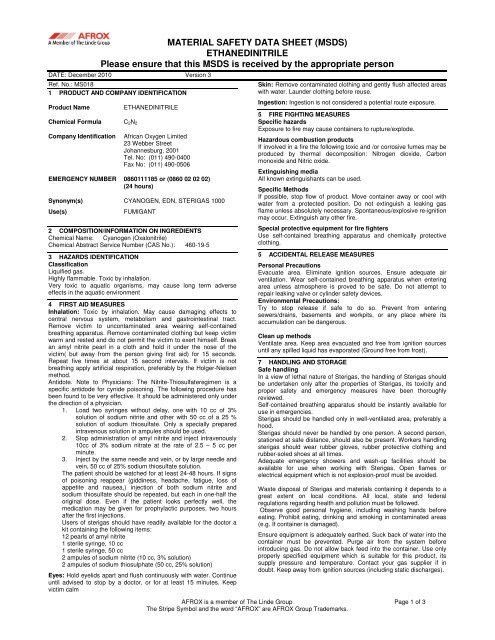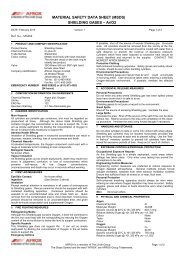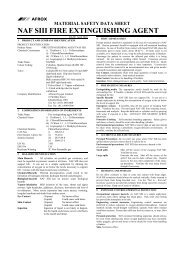Ethanedinitrile - Afrox
Ethanedinitrile - Afrox
Ethanedinitrile - Afrox
Create successful ePaper yourself
Turn your PDF publications into a flip-book with our unique Google optimized e-Paper software.
MATERIAL SAFETY DATA SHEET (MSDS)<br />
ETHANEDINITRILE<br />
Please ensure that this MSDS is received by the appropriate person<br />
DATE: December 2010 Version 3<br />
Ref. No.: MS018<br />
1 PRODUCT AND COMPANY IDENTIFICATION<br />
Product Name ETHANEDINITRILE<br />
Chemical Formula C2N2<br />
Company Identification African Oxygen Limited<br />
23 Webber Street<br />
Johannesburg, 2001<br />
Tel. No: (011) 490-0400<br />
Fax No: (011) 490-0506<br />
EMERGENCY NUMBER 0860111185 or (0860 02 02 02)<br />
(24 hours)<br />
Synonym(s) CYANOGEN, EDN, STERIGAS 1000<br />
Use(s) FUMIGANT<br />
2 COMPOSITION/INFORMATION ON INGREDIENTS<br />
Chemical Name: Cyanogen (Oxalonitrile)<br />
Chemical Abstract Service Number (CAS No.): 460-19-5<br />
3 HAZARDS IDENTIFICATION<br />
Classification<br />
Liquified gas.<br />
Highly flammable. Toxic by inhalation.<br />
Very toxic to aquatic organisms, may cause long term adverse<br />
effects in the aquatic environment<br />
4 FIRST AID MEASURES<br />
Inhalation: Toxic by inhalation. May cause damaging effects to<br />
central nervous system, metabolism and gastrointestinal tract.<br />
Remove victim to uncontaminated area wearing self-contained<br />
breathing apparatus. Remove contaminated clothing but keep victim<br />
warm and rested and do not permit the victim to exert himself. Break<br />
an amyl nitrite pearl in a cloth and hold it under the nose of the<br />
victim( but away from the person giving first aid) for 15 seconds.<br />
Repeat five times at about 15 second intervals. If victim is not<br />
breathing apply artificial respiration, preferably by the Holger-Nielsen<br />
method.<br />
Antidote. Note to Physicians: The Nitrite-Thiosulfateregimen is a<br />
specific antidode for cynide poisoning. The following procedure has<br />
been found to be very effective. It should be administered only under<br />
the direction of a physician.<br />
1. Load two syringes without delay, one with 10 cc of 3%<br />
solution of sodium nitrite and other with 50 cc of a 25 %<br />
solution of sodium thiosulfate. Only a specially prepared<br />
intravenous solution in ampules should be used.<br />
2. Stop administration of amyl nitrite and inject intravenously<br />
10cc of 3% sodium nitrate at the rate of 2.5 – 5 cc per<br />
minute.<br />
3. Inject by the same needle and vein, or by large needle and<br />
vein, 50 cc of 25% sodium thiosulfate solution.<br />
The patient should be watched for at least 24-48 hours. If signs<br />
of poisoning reappear (giddiness, headache, fatigue, loss of<br />
appetite and nausea,) injection of both sodium nitrite and<br />
sodium thiosulfate should be repeated, but each in one-half the<br />
original dose. Even if the patient looks perfectly well, the<br />
medication may be given for prophylactic purposes, two hours<br />
after the first injections.<br />
Users of sterigas should have readily available for the doctor a<br />
kit containing the following items:<br />
12 pearls of amyl nitrite<br />
1 sterile syringe, 10 cc<br />
1 sterile syringe, 50 cc<br />
2 ampules of sodium nitrite (10 cc, 3% solution)<br />
2 ampules of sodium thiosulphate (50 cc, 25% solution)<br />
Eyes: Hold eyelids apart and flush continuously with water. Continue<br />
until advised to stop by a doctor, or for at least 15 minutes. Keep<br />
victim calm<br />
Skin: Remove contaminated clothing and gently flush affected areas<br />
with water. Launder clothing before reuse.<br />
Ingestion: Ingestion is not considered a potential route exposure.<br />
5 FIRE FIGHTING MEASURES<br />
Specific hazards<br />
Exposure to fire may cause containers to rupture/explode.<br />
Hazardous combustion products<br />
If involved in a fire the following toxic and /or corrosive fumes may be<br />
produced by thermal decomposition: Nitrogen dioxide, Carbon<br />
monoxide and Nitric oxide.<br />
Extinguishing media<br />
All known extinguishants can be used.<br />
Specific Methods<br />
If possible, stop flow of product. Move container away or cool with<br />
water from a protected position. Do not extinguish a leaking gas<br />
flame unless absolutely necessary. Spontaneous/explosive re-ignition<br />
may occur. Extinguish any other fire.<br />
Special protective equipment for fire fighters<br />
Use self-contained breathing apparatus and chemically protective<br />
clothing.<br />
5 ACCIDENTAL RELEASE MEASURES<br />
Personal Precautions<br />
Evacuate area. Eliminate ignition sources. Ensure adequate air<br />
ventilation. Wear self-contained breathing apparatus when entering<br />
area unless atmosphere is proved to be safe. Do not attempt to<br />
repair leaking valve or cylinder safety devices.<br />
Environmental Precautions:<br />
Try to stop release if safe to do so. Prevent from entering<br />
sewers/drains, basements and workpits, or any place where its<br />
accumulation can be dangerous.<br />
Clean up methods<br />
Ventilate area. Keep area evacuated and free from ignition sources<br />
until any spilled liquid has evaporated (Ground free from frost).<br />
7 HANDLING AND STORAGE<br />
Safe handling<br />
In a view of lethal nature of Sterigas, the handling of Sterigas should<br />
be undertaken only after the properties of Sterigas, its toxicity and<br />
proper safety and emergency measures have been thoroughly<br />
reviewed.<br />
Self-contained breathing apparatus should be instantly available for<br />
use in emergencies.<br />
Sterigas should be handled only in well-ventilated area, preferably a<br />
hood.<br />
Sterigas should never be handled by one person. A second person,<br />
stationed at safe distance, should also be present. Workers handling<br />
sterigas should wear rubber gloves, rubber protective clothing and<br />
rubber-soled shoes at all times.<br />
Adequate emergency showers and wash-up facilities should be<br />
available for use when working with Sterigas. Open flames or<br />
electrical equipment which is not explosion-proof must be avoided.<br />
Waste disposal of Sterigas and materials containing it depends to a<br />
great extent on local conditions. All local, state and federal<br />
regulations regarding health and pollution must be followed.<br />
Observe good personal hygiene, including washing hands before<br />
eating. Prohibit eating, drinking and smoking in contaminated areas<br />
(e.g. If container is damaged).<br />
Ensure equipment is adequately earthed. Suck back of water into the<br />
container must be prevented. Purge air from the system before<br />
introducing gas. Do not allow back feed into the container. Use only<br />
properly specified equipment which is suitable for this product, its<br />
supply pressure and temperature. Contact your gas supplier if in<br />
doubt. Keep away from ignition sources (including static discharges).<br />
AFROX is a member of The Linde Group Page 1 of 3<br />
The Stripe Symbol and the word “AFROX” are AFROX Group Trademarks.
MATERIAL SAFETY DATA SHEET (MSDS)<br />
ETHANEDINITRILE<br />
Please ensure that this MSDS is received by the appropriate person<br />
Storage<br />
Segregate from oxidant gases and other oxidants in store. Cylinders<br />
should be stored: upright, prevented from falling, in a secure area;<br />
below 50 o C in a dry, well ventilated area constructed of noncombustible<br />
material with a firm level floor (concrete), away from<br />
areas of heavy traffic and emergency exits.<br />
8 EXPOSURE CONTROLS/PERSONAL PROTECTION<br />
Exposure limit value<br />
Value type Value Note<br />
TLV (ACGIH) 10ppm ACGIH 1995 -1996<br />
TWA-OEL-RL 10ppm OHS Act 85 of 1993<br />
Personal Protection<br />
Wear splash-proof goggles to protect eyes, face and skin from liquid<br />
splashes. Ensure adequate ventilation. Keep suitable chemically<br />
resistant protective clothing readily available for emergency use. Do<br />
not smoke while handling product. Keep self-contained breathing<br />
apparatus readily available for emergency use. Carry working gloves<br />
and protection shoes while handling gas cylinders.<br />
9 PHYSICAL AND CHEMICAL PROPERTIES<br />
PHYSICAL DATA<br />
Chemical Symbol C2N2<br />
Molecular Weight 52.04 g/mol<br />
Boiling point @ 101,325 kPa -21.17 o C<br />
Density, liquid @ -40 o C 0.9896<br />
Relative density, Gas @ 101,325 kPa 1.817<br />
Latent heat of fusion @ -27.9ºC 155.83kJ/kg<br />
Colour Colourless<br />
Odour Almond like odour<br />
10 STABILITY AND REACTIVITY<br />
Stability and Reactivity<br />
Can form explosive mixture with air. May react violently with oxidants.<br />
Materials<br />
Glass-lines equipment is satisfactory for conveying or processing<br />
cyanogens. Stainless steel, monel and inconel are also satisfactory<br />
up to at least 65 o C.<br />
11 TOXICOLOGICAL INFORMATION<br />
Acute Toxicity May cause irritation to respiratory tract.<br />
12 ECOLOGICAL INFORMATION<br />
Environment<br />
ATMOSPHERE: Vapour-phase cyanogens is slowly degraded in the<br />
atmosphere by reaction with photochemically produced hydroxyl<br />
radicals. SOIL: Cyanogen is expected to volatise from soil surfaces.<br />
WATER/BIOLOGICAL: Soluble cyanide compounds in water are<br />
expected to volatise from water surfaces or undergo microbial<br />
degradation. Does not contain class I or II ozone depleting chemicals<br />
13 DISPOSAL CONSIDERATIONS<br />
General: Avoid discharge to atmosphere. Do not discharge<br />
to any place where its accumulation could be dangerous.<br />
Do not discharge into areas where there is a risk of forming<br />
an explosive mixture with air. Waste gas should be<br />
flared through a suitable burner with flash back arrestor.<br />
Toxic and corrosive gases formed during combustion should<br />
be scrubbed before discharge to atmosphere.<br />
Contact supplier if guidance is required.<br />
14 TRANSPORT INFORMATION<br />
ADR/RID<br />
Class 2 Classification Code 2TF<br />
UN number and proper shipping name<br />
UN 1026 Cyanogen<br />
Labels 2.3,<br />
2.1<br />
Hazard number 263<br />
IMDG<br />
Class 2.3<br />
UN number and proper shipping name<br />
UN 1026 Cyanogen<br />
Labels 2.3,<br />
2.1<br />
Packing Instruction P200<br />
EmS FD,SU<br />
Other transport information : Ensure vehicle driver is aware of the<br />
potential hazards of the load and knows what to do in the event of an<br />
accident or an emergency. Before transporting product containers<br />
ensure that they are firmly secured. Ensure that the cylinder valve is<br />
closed and not leaking. Ensure that the valve outlet cap nut or plug<br />
(where provided) is correctly fitted. Ensure that the valve protection<br />
device (where provided) is correctly fitted. Ensure adequate<br />
ventilation. Ensure compliance with applicable regulations. Avoid<br />
transport on vehicles where the load space is not separated from<br />
driver’s compartment.<br />
15 REGULATORY INFORMATION<br />
SUPPLEMENT TO SANS 10234:2008<br />
Edition 1<br />
Annex A Index No. 608-011-00-8<br />
Precautionary statement codes<br />
Precautio<br />
nary<br />
statemen<br />
t code<br />
Precautionary<br />
Statement<br />
P210 Keep away from<br />
heat/sparks/open<br />
flames/hot<br />
surfaces – No<br />
smoking<br />
P261 Avoid breathing<br />
dust/fume/gas/mis<br />
t/vapours/spray<br />
P271 Use only outdoors<br />
or in a well<br />
ventilated area<br />
P273 Avoid release into<br />
the environment –<br />
if this is not the<br />
intended use<br />
P312 Call a POISON<br />
CENTRE or<br />
doctor/physician if<br />
you feel unwell<br />
P321 Specific treatment<br />
(reference to<br />
supplemental firstaid<br />
instruction)<br />
P377 Leaking gas fire:<br />
Do not extinguish,<br />
unless leak can be<br />
stopped safely<br />
P381 Eliminate all<br />
ignition sources if<br />
safe to do so<br />
P391 Collect spillage<br />
P304+<br />
P340<br />
P403+<br />
P233<br />
IF INHALED:<br />
Remove to fresh<br />
air and keep at<br />
rest in a position<br />
comfortable for<br />
breathing<br />
Store in a well<br />
ventilated place.<br />
Keep container<br />
tightly closed<br />
P405 Store locked up<br />
P501 Dispose of<br />
contents/container<br />
as a hazardous<br />
Hazard<br />
Statement<br />
code<br />
Hazard Statement<br />
H220 Extremely flammable<br />
gas<br />
H331 Toxic if inhlaled<br />
H410 Very toxic to aquatic<br />
life with long lasting<br />
effects<br />
AFROX is a member of The Linde Group Page 2 of 3<br />
The Stripe Symbol and the word “AFROX” are AFROX Group Trademarks.
waste<br />
16 OTHER INFORMATION<br />
MATERIAL SAFETY DATA SHEET (MSDS)<br />
ETHANEDINITRILE<br />
Please ensure that this MSDS is received by the appropriate person<br />
Ensure all national/local regulations are observed. Ensure operators<br />
understand the flammability hazard. Users of breathing apparatus<br />
must be trained. Ensure operators understand the toxicity hazard.<br />
Before using this product in any new process or experiment, a<br />
through material compatibility and safety study should be carried out.<br />
EXCLUSION OF LIABILITY<br />
Whilst AFROX made best endeavour to ensure that the information<br />
contained in this publication is accurate at the date of publication,<br />
AFROX does not accept liability for an inaccuracy or liability arising<br />
from the use of this information, or the use, application, adaptation or<br />
process of any products described herein.<br />
AFROX is a member of The Linde Group Page 3 of 3<br />
The Stripe Symbol and the word “AFROX” are AFROX Group Trademarks.




